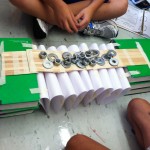Simple Machines! Technology! Structures! What do all these words have in common? They’re all types of innovations, which use engineering. Dictionary.com defines engineering as “the art or science of making practical application of the knowledge of pure sciences, as physics or chemistry, as in the construction of engines, bridges, buildings, mines, ships, and chemical plants.”
Engineering is one of the fourth grade science units. We began this unit with a mystery. Groups of students were given bags with different items inside. Each bag had several different items. Students were asked to reach in and identify an object inside the bag, without looking at it. Once the object was identified, the item was removed from the bag and the group determined the technology and the problem it solved. For example; an item might be a small plastic pencil sharpener. The technology is a wedge and a screw; the problem it solves is to sharpen the lead of a pencil.
There are many different kinds of bridges in the world. We learned about some types such as, suspension, beam, deep beam, and arch bridges. In groups of 3-4 students, we worked on building one of these forms of bridges or combinations of bridges. Each group had the following materials: popsicle sticks, straws, string, paper, masking tape, and 6 large books. After the bridge was built, we had to  test the bridge for strength, weight and weather. To test for strength, we tried to drive a toy car back and forth across the bridge three times. Washers and bolts were used to test the weight the bridge would hold; the expectation was that the bridge should hold 24 washers and 8 bolts. The final test given to each bridge was a simulation of an earthquake by shaking the bridge. 5 of the 6 groups were successful with their bridge construction.
test the bridge for strength, weight and weather. To test for strength, we tried to drive a toy car back and forth across the bridge three times. Washers and bolts were used to test the weight the bridge would hold; the expectation was that the bridge should hold 24 washers and 8 bolts. The final test given to each bridge was a simulation of an earthquake by shaking the bridge. 5 of the 6 groups were successful with their bridge construction.
We finished the unit by experimenting with simple machines, such as hammers, drills, screws, and screwdrivers. Following this we had to take a written exam.
Mrs. Wasik returned to Chickering School this year from a leave of absence. Prior to her leave she taught the Oceanography Science Unit in fourth grade. This year she is teaching the Engineering Science Unit. We were curious as to which unit she liked better. In Oceanography, she loved learning about the adaptations of different sea creatures. She discovered that technology is not just computers but “could be anything that solves a problem, such as a chair”. After she taught the Engineering Unit for the first time, she has decided she likes both equally.
We asked her what she wanted the students to learn about engineering. She wants everybody to know that technology is anything that solves a problem and that engineers both design and improve technology. Another question was what are all the fourth grade science units. The science units are: Plants, Sound and Light, Oceanography, Rocks and Minerals, and Engineering as determined by the Massachusetts Department of Elementary and Secondary Education.
We wondered how she thought the students did collaborating together building their bridges. She said the students learned to listen to each other, to share ideas, and to encourage everyone to participate in the group. As the unit continued, Mrs. Wasik felt that the students improved more and more as they learned to work together.
If you like working in groups and using your hands to build things then this 4th grade science unit is for you!
Reported by: George, Marley, and Sophie
Well done! This is a great story about Mrs. Wasik and her science unit. (You might know that I LOVE science, and especially engineering.)
I liked how you embedded the video and all the background information about the science and Mrs. Wasik.
Thank you.
Great Work! I really enjoyed learning more about Mrs. Wasik and her very cool science unit.
The video was a fantastic touch. It really added to the story.
Thanks!
George, Marley, and Sophie,
I love the video. It showed your class creativity, engagement, and just pure FUN that everyone had while learning about bridges.
Thanks for sharing.
Very professional article. You made me see technology in a new light- problem solving in everyday life (not just computers). Keep up the great work. Bloggers in 4th grade. Wow!
Marley’s a blogger! Great job! We are all following you from the office in Boston!
George, Marley and Sophie – what a great report. I’ve never thought about technology being anything that solves a problem. I thought that was a very interesting perspective. I also thought the bridge video was very cool – I love the music that went with it.
Thanks!
Marcus Hatfield
Wow! Oceanography Science Unit, Engineering Science Unit… If this is the curriculum in forth grade now then I am totally going to be out of a job in 12 years. Very impressive!
I especially like the paragraph about how well you all collaborated and shared ideas. That’s what makes learning together fun!
Well done you guys!